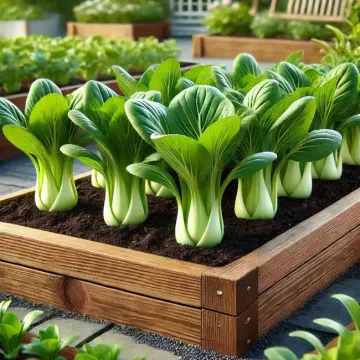Bok choy, also known as pak choi or Chinese cabbage, is a versatile and nutritious leafy green that is a staple in many Asian cuisines. It is part of the Brassica family, which includes other garden favorites like broccoli, kale, and cabbage. Growing bok choy in your home garden can be a rewarding experience, as this fast-growing vegetable offers fresh, tender leaves that can be used in a variety of dishes. This article will guide you through the process of growing bok choy at home, from planting to harvesting, and offer tips to ensure a successful crop.
History of Bok Choy
Bok choy has a rich history dating back over 1,500 years to its origins in China, where it has long been cultivated as an essential vegetable. Over time, it spread throughout Asia and eventually made its way to other parts of the world due to its popularity in international cuisine. Bok choy has become a favorite among gardeners for its quick growth and ease of care.
Health Benefits of Bok Choy
Bok choy is highly nutritious, offering a range of health benefits. It is low in calories but packed with vitamins and minerals, particularly vitamins A, C, and K, as well as calcium, magnesium, and potassium. Its high fiber content makes it excellent for digestive health, and the antioxidants found in bok choy help protect the body from free radicals. Additionally, bok choy is a good source of folate, which is important for heart health and during pregnancy.
Culinary Uses of Bok Choy
Bok choy's mild flavor and crisp texture make it a versatile ingredient in the kitchen. It is commonly used in stir-fries, soups, and salads. The entire plant is edible, including both the tender leaves and the crunchy stalks. Bok choy can be sautéed, steamed, grilled, or even eaten raw in salads. Its ability to absorb the flavors of accompanying ingredients makes it a popular choice in a variety of dishes.
Growing Bok Choy in the Home Garden
1. Choosing the Right Variety Bok choy comes in several varieties, with both full-sized and baby bok choy being popular options for home gardeners. Baby bok choy is smaller and more tender, while full-sized varieties can grow up to 12-18 inches tall. Choose a variety based on your space and culinary preferences.
2. Planting Bok Choy Bok choy is a cool-season crop that thrives in the early spring and fall. It prefers temperatures between 55°F and 70°F. It can be grown from seeds or transplants, and it matures quickly, often within 45-60 days.
- Soil: Bok choy prefers well-draining, fertile soil with a pH between 6.0 and 7.5. Adding compost to the soil before planting can help improve fertility and moisture retention.
- Spacing: When planting seeds, space them about 6 inches apart in rows that are 12-18 inches apart. If you are planting transplants, space them about 12 inches apart.
- Watering: Bok choy requires consistent moisture, so be sure to water it regularly. However, avoid overwatering, as this can lead to root rot.
- Sunlight: Bok choy thrives in full sun but can also tolerate partial shade, especially in warmer climates where too much heat can cause it to bolt (flower prematurely).
3. Care and Maintenance
- Thinning: Once seedlings are a few inches tall, thin them to allow proper spacing and avoid overcrowding.
- Mulching: Apply mulch around the plants to help retain moisture, keep the soil cool, and suppress weeds.
- Pests and Diseases: Bok choy is susceptible to common garden pests like aphids, flea beetles, and cabbage worms. Inspect plants regularly and use organic pest control methods such as neem oil or insecticidal soap if necessary. Row covers can also help protect plants from pests. Additionally, watch for signs of disease, such as powdery mildew, and remove affected leaves promptly.
4. Harvesting Bok Choy Bok choy is ready to harvest when the heads are firm and the leaves are tender. Baby bok choy can be harvested when the plants are about 6 inches tall, while full-sized varieties should be harvested when they reach 12-18 inches in height. Use a sharp knife to cut the plant at the base, or harvest individual leaves as needed. Bok choy can be stored in the refrigerator for up to a week, though it is best when used fresh.
5. Succession Planting To enjoy a continuous harvest of bok choy, consider succession planting. This involves planting seeds every 2-3 weeks to ensure that you have a steady supply of bok choy throughout the growing season. Succession planting works especially well in cooler climates where bok choy can be grown into the fall.
Bok choy is an easy-to-grow vegetable that can be a valuable addition to your home garden. Its quick growth, minimal care requirements, and versatility in the kitchen make it a favorite among gardeners. Whether you are a seasoned gardener or just starting out, growing bok choy offers a rewarding experience with delicious results. Enjoy the fresh, crisp leaves of bok choy in your favorite dishes and reap the nutritional benefits of this ancient vegetable.

